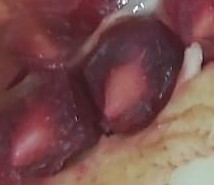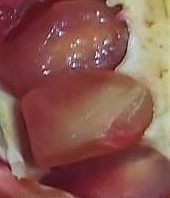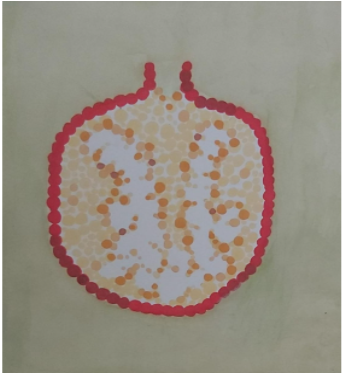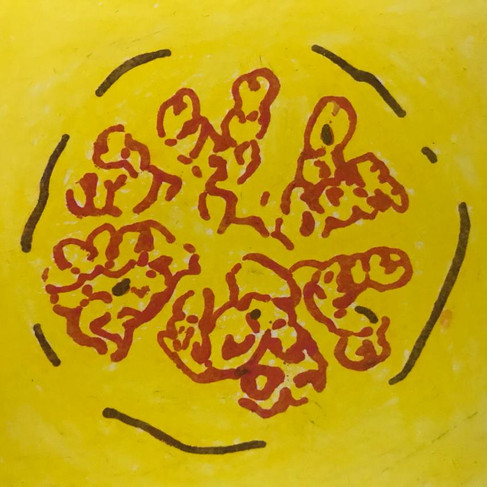END-TERM PROJECT
- Rachel Tom Antony
- Nov 21, 2021
- 6 min read
Updated: Dec 12, 2021
PRE-WORK :
(Pomegranate)
There were some details that I had noted before starting out with my organic form. They are as follows:
Form- The shape of my organic form was not a proper sphere. There were very small dents in a few areas. I also observed that there were only few seeds that were visible.
Texture- There were three main texture I focussed on. The seeds had a very smooth, firm texture, the outer skin had a slightly rough texture and the inner flesh had a very bumpy texture.

Colour- The outside skin had a bright dark pink colour to it. The inside was of a pale yellow colour with certain areas slightly pinkish. Some seed had a pink colour whereas some had a purplish- brownish colour.
Materials used:
Plaster of Paris, tissue paper, paper, hot glue, fevicol, acrylic paints, markers.
Process:
The body of the pomegranate was made with plaster of paris. I then added tissue paper to give it a more organic feel by reducing the firmness.
The seeds were created by first drawing it on paper using markers and then adding hot glue over it to give it a more jewel like look.
The body of the pomegranate was coloured using acrylic paint.
FEED BACKS:
There were two main problems with my 3-d model, they were as follows:
I didn't replicate the actual shape of a pomegranate which has a slightly more angular shape. My 3-d model was very round.

I also did not look into the positioning of the seeds in an actual pomegranate. In my version the seeds were just randomly placed.
FORM ANALYSIS - 1 :
During this stage we were asked to show a study of our fruit on an A3 size paper. In the beginning I found it difficult to differentiate what all drawing are considered as the study of the fruit and what all were illustrative.

This confusion arose because through the above drawing I was trying to represent the texture and glossy appearance of a pomegranate seed but it was still considered as a illustrative drawing rather than a study.
However after hearing the feedbacks I started understanding the difference between the two. This understanding is somewhat evident in my later sketches shown below:
(Inner texture of the pomegranate peel, outer texture of the peel)
In both cases, I was trying to capture the texture and the appearance but the difference was in how I represented them. In the first example I had used a very detailed realistic colour drawing whereas in the second example, I had used a simple black line drawing to capture the texture. I realised that a study did not require a highly detailed, realistic or aesthetically pleasing composition. I also understood that one can represent details like the texture of the peel etc, through simple lines and shapes.
While I was getting the feedbacks for the next stage, I was introduced to a very important aspect/character of the pomegranate which was completely missed out in my earlier study which was the outer form of the fruit. Since I couldn't fully grasp this, I was given a task by my tutors where I had to take the horizontal slices of my fruit, understand it planes and draw them on a sheet of paper.
After doing this task, I realised how angular the fruit is. It was also brought into my notice by my tutors how the seeds were in the position of a seven point star and this had a direct correlation with the number of planes which was also seven.
From this I was able to understand how many obvious details I was missing out on because I was focussed on only one aspect of the fruit (position of the seeds).
This understanding also made me think that there might be patterns associated with number 7 in the fruit. On closer study of the same, I found that this pattern unfortunately does not follow all throughout the fruit.
FORM ANALYSIS - 2:
During this stage we were introduced to a different method of representing our fruit. During my earlier sessions in F2F, I had used a similar technique to represent a cylinder.

As mentioned previously, it is during this stage that I truly understood how angular my fruit is. After this understanding when I made a second attempt I could clear difference between both my attempts.
( Right - first attempt,
Left - second attempt )
IDEA GENERATION:

During this stage we were introduced to Gestalt theory and were asked to generate maximum number of ways to represent a pomegranate. In the first mentoring session it was brought to my notice that I was taking a more intricate and detailed approach and I was suggested to try out more graphic and geometrical ones.
During this stage, I found that the practice of generating ideas within a short period of time during Think Lab sessions to be very useful.
Another aspect that I did not look into before receiving the feedbacks was the material explorations. I had created a large variety in my 2-d explorations but such variety and quantity was not found in the 3-d explorations. This aspect was however looked into after it was pointed out in mentoring session.
During this stage I was also able to utilise one form that I had created that had not come out right in F2F to recreate the overall form of a pomegranate.
IDEA DEVELOPEMENT:

This was a stage where I did face some struggle because it came to expanding ideas that I had earlier thought did not require further improvement. However I did overcome this struggle after I realized how much improvement can be done to each exploration by some simple, minor manipulations.
( For eg, I was able to add dimension to the first drawing by simply manipulating the thickness of the lines and by using curved lines instead of straight lines.)
I also realised how useful the thinking tool, S.C.A.M.P.E.R. taught in Think Lab was useful during this stage.
EXPLORING COLOUR:
During EOC-1 I had learnt that every colour has meanings and emotions connected to it. So during this stage, I thought of utilising this understanding by trying to associate the different aspects of the fruit with different colours. For example, the seed of the pomegranate is sweet and this can be communicated by using a pink background. It is also sour and this aspect can be communicated using a bright yellow background.
During the feedbacks. it was brought into my notice that while my entire focus was on choosing the background colour, I had ignored looking into the actual shades and tints of pink, brown and yellow of the pomegranate. I was also old that there was a potential to improve my drawings as well to communicate the fruit better.
I tried making changes as per the feedbacks given in the next stage.
EXPLORING SPACE:

During this stage, I decided to choose one of the drawings that I had earlier planned on rejecting because the contrast between the figure and background was very little because the background gave a very organic and tropical feel which attracted my attention to it. With slight modifications that I had earlier mentioned I was able to solve the contrast issue as well.

The reason why I chose the green background was because it gave the drawing a sense of freshness which I believe is something that can always be associated with this fruit.

During this stage, two aspect that I explored was dividing the drawing into multiple parts
and playing with positions.
One aspect I wished I had explored more was in playing with scale. The various sizes I chose did not have a drastic difference and because of this the various sizes used are not noticeable.
FINAL SELECTION:
(3-d outcome) :
After this long study of a pomegranate, I wanted to take a more realistic approach to show my understanding of the fruit.
(2-d digital outcome) :
In the first set of options, since the background colour conveyed freshness I wanted the pomegranate to also reflect that fresh new feel. I thought the best way to do this was by going a little further by dividing it into multiple parts and exploring positions.
In the second choice, the drawing was a little more detailed and so I didn't want to take an extreme approach which might end up not communicating my fruit. Thus, I went for a more simplistic approach. I also wanted to avoid symmetry since the background gave a organic sense to the composition. I didn't want to contradict that organic feel with symmetry.
CONCLUSION:
Overall the entire experience brought into my awareness so many things about the fruit and about myself. I was able to make an attempt of going beyond just noticing details to establishing relations and finding patterns between these various components. Even though most of the time I was unsuccessful, I was at least able to take the first step of trying it out.
Lot of my strengths and weaknesses were also recognised by me during this project.
Strengths:
I was successful in expanding data and utilising the earlier learnt concepts and theories during the project.
I was able to stay motivated throughout the entire journey even though it was extremely tiring.
I was also able to communicate a lot more with my tutors during this project unlike in the Illustrated Vector Map project. I also noticed how much my work improved with these daily mentoring sessions.
Weakness:
I constantly kept on missing many details. I realised that I need to work a lot more in improving my observation skills.
I felt like I struggled a lot on choosing the best outcome out of a large set of options.
I feel like I was relying a lot on the guidance provided by my tutors and was not really confident in my own decisions.







































































































































Comments